The U.S. Geological Survey reports that the summit eruption of Kilauea Volcano has ceased within the Halemaumau crater. More so, lava has stopped pouring on the crater floor, the site of all recent eruptive activity. No substantial changes have been recorded along either of the volcano's rift zones.

USGS workers observe lava from a Kilauea volcano fissure in Leilani Estates, on Hawaii's Big Island, on May 24, 2018, in Pahoa, Hawaii. An estimated 40-60 cubic feet of lava per second is gushing from volcanic fissures in Leilani Estates.
No More Volcanic Activity
The USGS's Hawaiian Volcano Observatory said in their report that small ooze-outs of lava were flowing slowly in the footprint of the western lava lake on Monday, March 6, within the basin that was created during the end of the 2021-2022 eruption.
However, the ooze-out activity stopped in the afternoon until Tuesday, March 7; authorities no longer detected active lava in Halemaʻumaʻu crater. Moreover, monitoring data showed that there is no new lava being formed under the crater floor, although they are still on alert for possible previously accumulated lava to feed further ooze-outs at the surface.
Webcam images taken overnight show that many hornitos on the crater floor are still blazing, but authorities clarified that they are not spouting any lava. The current slowdown in activity is attributable to a significant deflationary tilt signal that began on February 17.
The deflationary tilt signal is a standard process at Kilauea Volcano that involves deflating the volcano's ground for hours or days. As pressure continues to drop, it also causes volcanic eruptions to stop. The USGS released live-stream footage of the dormant western lava lake region.
The net tilt has increased somewhat throughout these deflation/inflation (DI) events, although the summit remains deflated compared to the preceding February 17. If the peak re-inflates to its previous elevation, eruptive activity on the Halemaumau crater floor may restart.
In recent weeks, volcanic tremor has decreased marginally, nearing background levels. On February 28, a sulfur dioxide (SO2) emission rate of approximately 250 tonnes per day (t/d) was detected.
READ ALSO: Deadly Lava Lake Is Bubbling in Hawaii's Kilauea Volcano Hitting Extreme Temperatures
Risk Assessment of Kilauea Volcano's Condition Now
Kilauea Volcano has been recently active, spewing high levels of volcanic gas that can have far-reaching effects downwind. Phys.org reports that the volcano erupted again on January 5, 2023, after scientists detected a glow at its Halemaumau Crater. The eruption began after almost a monthlong pause in volcanic activity.
USGS experts said that large amounts of volcanic gas made up of water vapor, carbon dioxide, and sulfur dioxide are continuously ejected during volcanic eruptions. These hazardous gases react in the atmosphere and create volcanic smog, also known as vog, that has been observed downwind of the volcano.
Vog creates airborne hazards to people, damages crops and other plants, and affects livestock. Additionally, the volcanic eruption causes Pele's hair and other volcanic glass fragments from lava fountains that may be wafted through strong winds, maximizing exposure to volcanic particles.
Lastly, Halemaʻumaʻu crater wall is unstable, and it might result in ground cracking and rockfalls. A potential earthquake due to volcanic activity also poses hazards.
RELATED ARTICLE: Hawaiian Volcanoes Sudden Silence: Is It the End of Mauna Loa and Kilauea or an Upcoming Danger?
Check out more news and information on Volcano Eruptions on Science Times.














